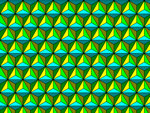 In the last post, the topic was the complex shapes known as fractals. For this post, we'll simplify things by dealing with nice, simple repeating shapes.
In the last post, the topic was the complex shapes known as fractals. For this post, we'll simplify things by dealing with nice, simple repeating shapes.
Patterns that repeat without leaving any gaps or overlapping areas are known as tessellations, and they're a great way to mix fun and creativity with math.
Let's start with the basics and some inspiration, with help from Square One TV:
It's easy to see how many perfect geometric shapes can be repeated, so this can seem somewhat restricting. It seems to be a nice technique if you, say, want to create a honeycomb pattern, but what else can you really do with it?
If you're familiar with the works of M. C. Escher, you'll recall he did a great deal of work with tessellations. Most impressively, his shapes weren't simple and flat, but interesting shapes such as horses, riders, angels, demons, fish, and many more!
The video below will show you how to start with simple triangles, and get you started on creating your own wildly-tessellating creations:
One of the tessellating shapes Escher is best remembered for is his lizard patterns. It's so recognizable, yet somehow still repeats in a surprising way.
It's hard enough to solve a jigsaw puzzle with a tessellating pattern, but at least you have the different shapes of the pieces to help you. What if the shapes of the pieces themselves were those tessellating lizards, and thus were all the same shape? At least with that online version, you still have flat sides, so you can at least start with the edges. The makers of the Shmuzzle Puzzles take away that advantage by making every piece an identical shape!
When you play with tessellations enough, you'll realize that you start to see the same base shapes used as starting points. While it's obvious you can't use just any shapes, you may be surprised to learn that not all regular geometric shapes are suited to these repeating patterns. Most notably, the humble pentagon doesn't tessellate on it's own.
The main problem the pentagon has is that each of its internal angles is 108°, which doesn't divide evenly into 360°. Of course, just because a shape can't tessellate on it's own, doesn't mean you can't find other shapes that will work with it. To learn more about how mathematicians learned to tame the pentagon, read Craig Kaplan's article, The trouble with five.
I can only begin to give you a taste of the fun you can have with tessellations in this post. To explore even further, check out tessellations.org. My favorite there is the their chess set designs. Look around that site, and you may be surprised at what you find enjoyable and inspiring.
0
Related Posts
Subscribe to:
Post Comments (Atom)




No Response to "Tessellations"
Post a Comment